Buffish Mining Bee - Andrena nigroaenea
As I walked along a coastal path during the first week of May on a sunny day, camera in hand, I spotted several Nomada bees flying around and foraging on a mixed patch of wildflowers along a grassy bank.
As soon as I see Nomada of any species, I’m quite sure its host will be nearby. It took me less than a minute to locate the host nest site – an aggregation of mining bee nests belonging to the buffish mining bee – Andrena nigroaena.
About The Buffish Mining Bee
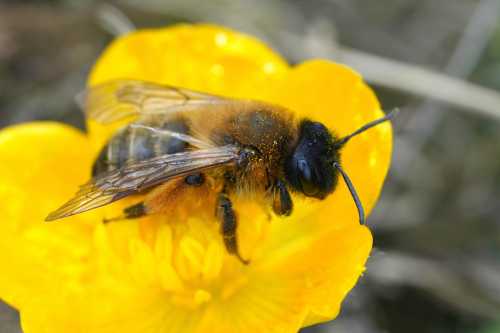 Buffish mining bee (female)
Buffish mining bee (female)Females buffish mining bees are
about 10 – 11mm in length, males about 8 – 10mm – although Falk reports that males
are somewhat variable in size, and comparatively large specimens are sometimes
encountered.
They can be seen from mid-March onwards through to the end of July. They are at their peak from April to May.
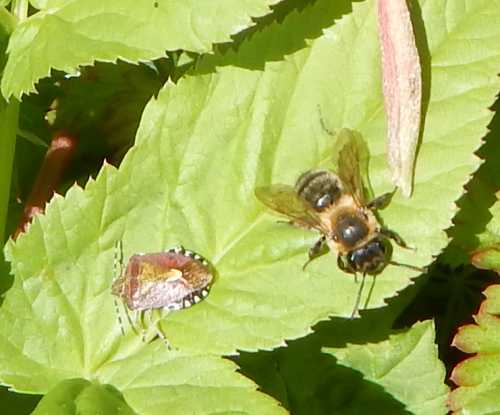 Shield bug (left) with female buffish mining bee, resting on leaf.
Shield bug (left) with female buffish mining bee, resting on leaf.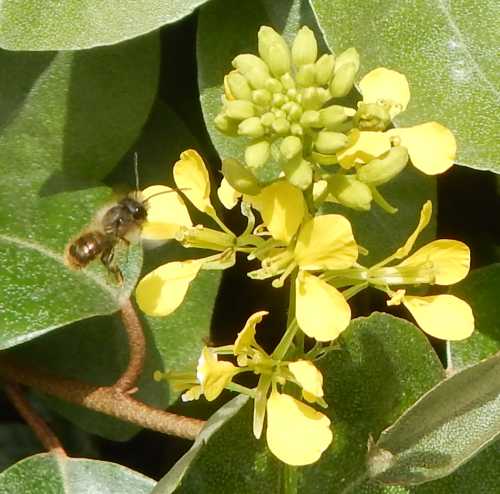 Buffish mining bee - Andrena nigroaena (male).
Buffish mining bee - Andrena nigroaena (male).
Habitat
This particular bee species is found in a variety of habitats, including urban areas and farmland.
On this occasion, the bees were seen just off a coastal pathway. The location of the nest burrows was a grassy bank lined by a variety of shrubs, bushes and trees, and opposite was a small industrial estate.
Further along, the coastal path is flanked by fields, hedgerow, gorse and wildflowers.
In the opposite direction and a little further inland, larger stretches of rough scrubland provide more gorse, teasels, and a lovely variety of wildflowers and small shrubby trees such as wild guelder rose, holly, small willows, and buddleia.
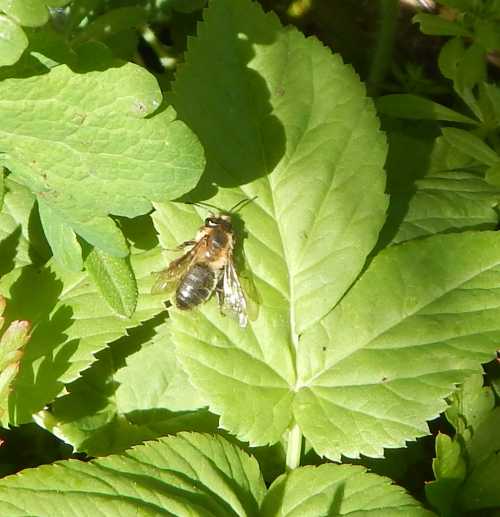 Buffish mining bees are found in a variety of habitats. On this occasion, the bees were seen just off a coastal pathway.
Buffish mining bees are found in a variety of habitats. On this occasion, the bees were seen just off a coastal pathway.Patches of bramble and nettle help to further ensure the area feeds bees, butterflies and birds alike, as well as small mammals.
Flowers Visited
Being polylectic, buffish mining bees visit a wide range of flowers from assorted plant families and types. The immediate area was surrounded by a variety of wildflowers as well as bushes and trees, including hawthorn, willow and gorse.
The males are, however, sometimes tricked into attempting to mate with the orchid, Ophrys sphegodes. The orchid emits chemicals resembling those given off by female Buffish mining bees. You can read more about this on my page: Orchids and Bees.
Nesting Habits
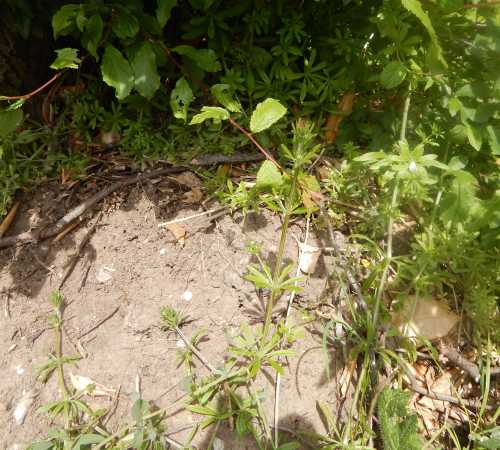 Location of buffish mining bee nest burrows. The bees had found a sunny bank with patches of bare earth.
Location of buffish mining bee nest burrows. The bees had found a sunny bank with patches of bare earth.The photograph above shows the location of the nest burrows.
As you can
see, the bees had found a sunny bank with patches of bare
earth. These burrows are close to the flowers,
trees and bushes that provide the bees with ample food with which to provision
their egg cells.
Whereas BWARs (Bees Wasp and Ants Recording Society) propose that this species nests singly, Steve Falk, author of Field Guide to Bees Of Great Britain And Ireland states that Andrena nigroaena nests in aggregations. My experience would reflect that of Falk.
However, it
is perhaps worth mentioning that other Andrena species have been found to nest both
singly and in groups, such as Andrena nigriceps – the black-headed mining bee;
the orange-tailed mining bee, Andrena haemorrhoa to name just two.
Parasites - and tips for spotting buffish mining bees and other Andrena species
Seeing the cleptoparasite
Nomada had instantly informed me that I might find its host, and indeed, the nest
burrows were located in patches of bare earth on a sunny bank beside the footpath.
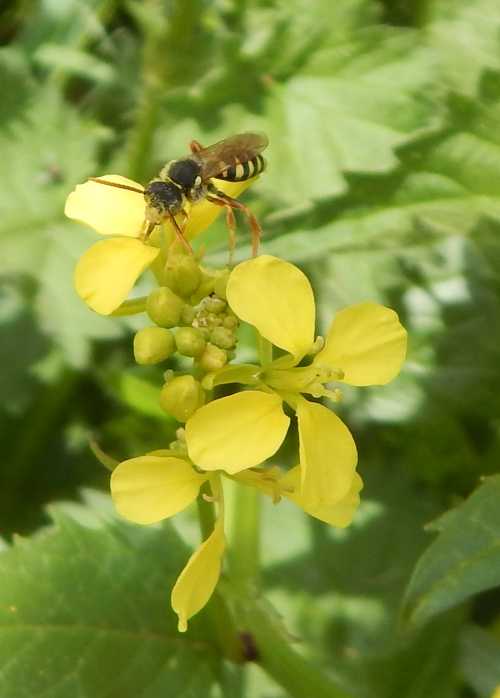 Gooden's nomad bee - Nomada goodeniana - cleptoparasite of the buffish mining bee.
Gooden's nomad bee - Nomada goodeniana - cleptoparasite of the buffish mining bee.In fact, if you can learn to recognise Nomada bees (even without necessarily knowing the name of the specific specimen) you will quickly find that it will help you spot various Andrena bees.
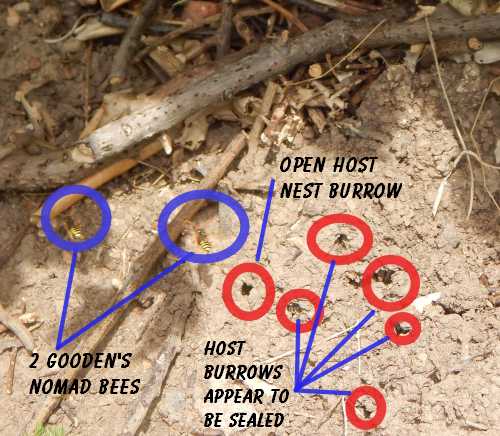 In this photograph you can see several burrows of the buffish mining bee. Look closely, and you can see that the entrances to some of them are already sealed, but at least one entrance remains fully open.
In this photograph you can see several burrows of the buffish mining bee. Look closely, and you can see that the entrances to some of them are already sealed, but at least one entrance remains fully open.
In the photograph above, there are several burrows of the buffish mining bee. Look closely, and you can see that the entrances to some of them are already sealed, but at least one entrance remains fully open.
In this image, there are also 2 Gooden's nomad bees - Nomada goodeniana pictured in flight close to the burrows. this is a cleptoparasite of our buffish mining bee
– Andrena nigroaena.
Gooden’s nomad bees typically wait around the entrances before entering the burrow, laying an egg in the wall of an unsealed cell, then leaving. Below, is an image of a Gooden's nomad bee is leaving the nest burrow. To the left you can see more clearly that the other nest burrows are sealed.
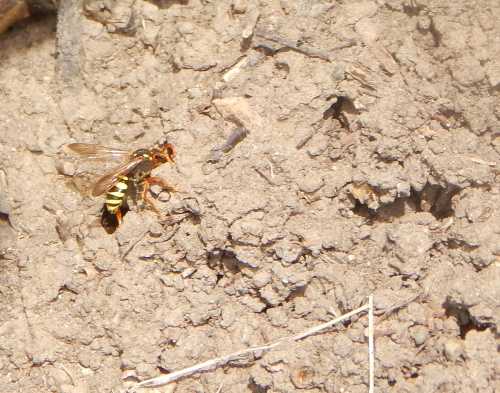 Gooden's nomad bee is leaving the nest burrow.
Gooden's nomad bee is leaving the nest burrow.Like other Nomada species, the Gooden's nomad bee is rather wasp-like in appearance. When her larva hatches from its egg, it will destroy the egg or grub of the host buffish mining bee, and will eat its food supplies. Another cleptoparasite of Andrena nigroaena is Marsham’s nomad bee – Nomada marshamella.
Mining bees...
- The Ashy Mining Bee - Andrena cineraria Identification, photos, habitat and nesting habits, parasites and flowers visited by this lovely bee.
- Painted mining bee - Andrena fucata - A medium-sized mining bee, with females around 9mm long, and males a little smaller. They are univoltine.
- The Chocolate Mining Bee - Andrena carantonica/scotica Images of 2 Chocolate mining bees mating, plus their habitats, nesting and foraging preferences.
- Grey-patched mining bee - Andrena nitida Images and description.
- Orange-tailed Mining Bee - Andrena haemorrhoa About the Orange-tailed Mining Bee: photos, habitat, foraging habits. Look out for the bright orangey hairs on the tip of the tail.
If you found this page helpful or interesting, I'd really be grateful if you would share it with others - if not this page, perhaps another, such as Gardening For Bees.
Thank you so much :) .